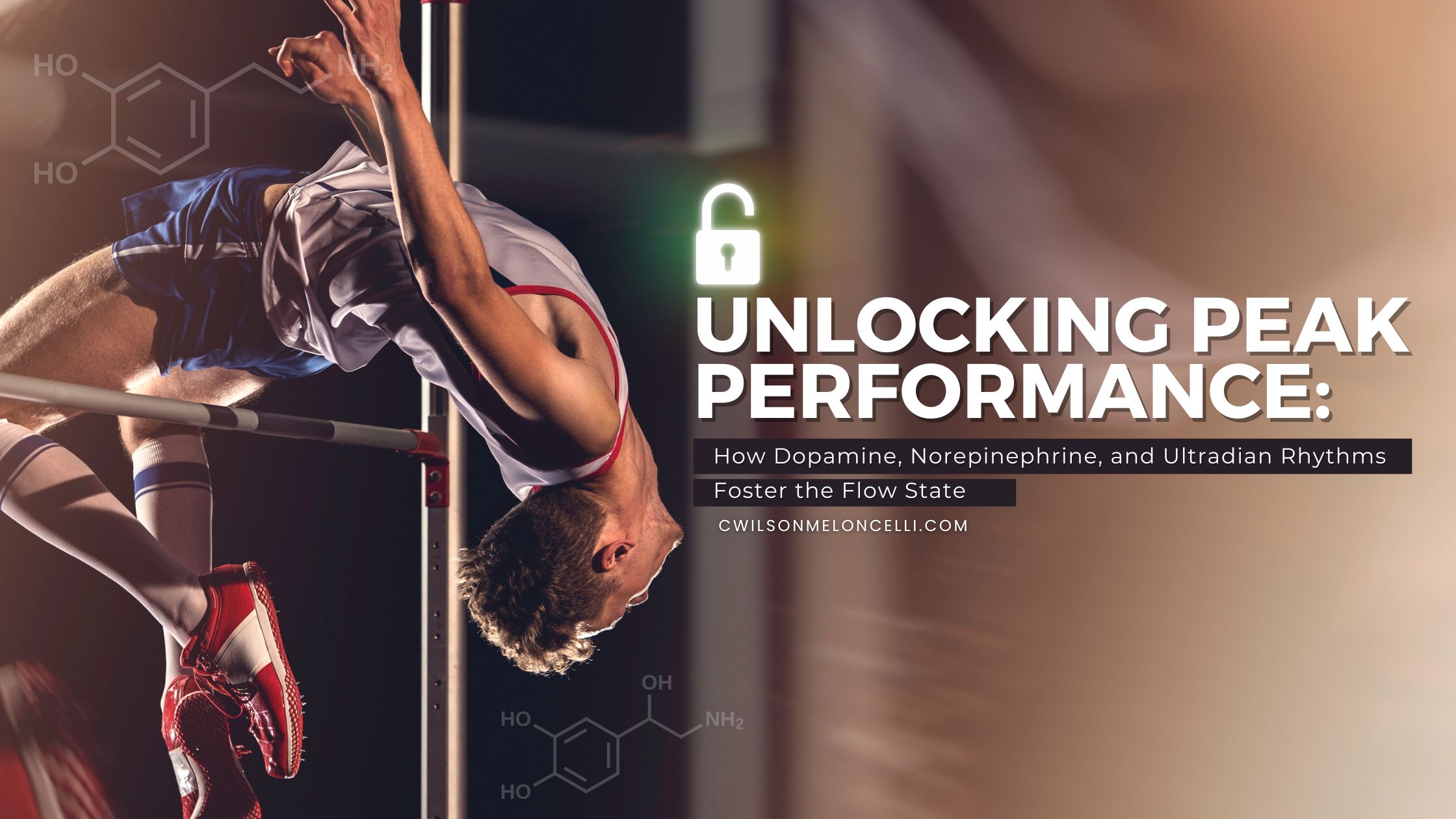
The concept of the "flow state" has captivated psychologists, athletes, and professionals alike. Defined by Mihály Csíkszentmihályi, flow is a state where individuals are fully immersed, focused, and enjoy their activities, often leading to peak performance. This state is closely linked to the optimal balance of neurotransmitters, particularly dopamine and norepinephrine, and is influenced by the natural ultradian rhythms of our bodies.
Dopamine and Norepinephrine: The Neurochemical Drivers of Flow
Dopamine and norepinephrine are crucial neurotransmitters that facilitate the flow state. Dopamine is often associated with reward, motivation, and pleasure, while norepinephrine is linked to arousal, alertness, and the fight-or-flight response.
Dopamine:
During activities that challenge us just the right amount, dopamine levels rise. This increase enhances our ability to focus and improves our mood, making tasks more enjoyable and engaging. High dopamine levels are particularly associated with the active phases of the ultradian rhythm, which typically last around 90 minutes. During these phases, individuals experience heightened alertness and cognitive performance.
Norepinephrine:
This neurotransmitter complements dopamine by increasing arousal and energy. It helps maintain attention and concentration, especially in response to new or challenging stimuli. The right balance of norepinephrine ensures that individuals remain engaged without becoming overwhelmed or anxious.
Ultradian Rhythms: The Natural Cycle of Activity and Rest
Ultradian rhythms are cycles shorter than 24 hours, with the 90-minute basic rest-activity cycle (BRAC) being particularly important to the flow state. These rhythms regulate periods of heightened activity and subsequent rest, ensuring that our bodies and minds can sustain prolonged periods of productivity without burnout.
- Activity Phases:
During the active phase of the 90-minute cycle, dopamine levels are higher. This increase in dopamine is associated with heightened alertness, improved cognitive performance, and greater physical activity. For example, dopamine's role in promoting wakefulness and enhancing attention aligns with the active periods of the BRAC.
- Rest Phases:
As the cycle progresses towards the 90-minute mark, dopamine levels decline, leading to a phase characterized by reduced activity and a need for rest. This reduction in dopamine corresponds with the body's natural inclination towards a rest period, which can manifest as decreased alertness and a propensity for taking breaks or experiencing a lull in performance.
- Replenishment Phases:
After the 90-minute cycle, there is a shorter, roughly 20-minute period during which the body and brain replenish resources. This phase can involve the re-synthesis of neurotransmitters like dopamine. During this time, lower dopamine activity allows for recovery and preparation for the next cycle of heightened activity. This replenishment phase is crucial for maintaining the balance and efficiency of the ultradian rhythm over the course of the day.
Flow State and Ultradian Cycles: A Synergistic Relationship
The flow state is most easily achieved when activities align with the natural peaks of the ultradian rhythm. Here’s how this relationship works:
- Entering Flow: At the start of the 90-minute active phase, dopamine and norepinephrine levels rise, enhancing motivation and focus. Engaging in activities that are enjoyable and suitably challenging during this time can trigger the flow state. The increased neurotransmitter levels create a sense of pleasure and immersion, essential characteristics of flow.
- Sustaining Flow: Maintaining the flow state requires continuous engagement and feedback. As tasks are completed and goals are achieved, dopamine provides the reward signals that keep individuals motivated. Norepinephrine ensures that attention remains sharp, helping individuals stay immersed in the activity.
- Transitioning from Flow: As the 90-minute cycle ends, it’s natural to transition out of the flow state. Recognizing the need for a break and allowing for a 20-minute rest period can help replenish neurotransmitter levels and prepare the brain for the next cycle of activity. Ignoring these natural rhythms can lead to decreased performance and burnout.
Practical Applications
Understanding the interplay between dopamine, norepinephrine, and ultradian rhythms can help optimize productivity and enhance the likelihood of achieving flow:
- Schedule Work According to Ultradian Rhythms: Plan intensive, challenging tasks during peak activity phases and schedule breaks around the 90-minute mark to align with natural rest periods.
- Create an Optimal Environment: Minimize distractions and create conditions that promote concentration and enjoyment, leveraging the natural boost in dopamine and norepinephrine during active phases.
- Balance Challenge and Skill: Ensure tasks are neither too easy nor too difficult. The right level of challenge can stimulate dopamine release, enhancing motivation and engagement.
The flow state is a highly desirable condition that can be better understood through the lens of neurotransmitter activity and ultradian rhythms. By aligning activities with these natural cycles and understanding the roles of dopamine and norepinephrine, individuals can enhance their ability to enter and sustain flow, leading to improved performance and greater satisfaction in their endeavors.
If you're looking to take your skill, sport or profession to the next then implementing what you have read here is the foundation. To learn more about dopamine, rhythms and the flow state, then watch this video on how to become a Mavericks of flow.

How Dopamine, Norepinephrine, and Ultradian Rhythms Foster the Flow State Infographic
References
- Frontiers in Neuroscience. "Dopaminergic Balance between Reward Maximization and Policy Complexity" - https://www.frontiersin.org/articles/10.3389/fnsys.2011.00022/full
- eLife. "A highly tunable dopaminergic oscillator generates ultradian rhythms of behavioral arousal" - https://elifesciences.org/articles/05105
- Frontiers in Physiology. "The Temperature Dependence of Sleep" - https://www.frontiersin.org/journals/neuroscience/articles/10.3389/fnins.2019.00336/full
- Frontiers in Psychiatry. "Disrupted Sleep and Circadian Rhythms in Schizophrenia and Their Interaction With Dopamine Signaling" - https://www.frontiersin.org/journals/neuroscience/articles/10.3389/fnins.2020.00636/full
- PLOS Computational Biology. "A mathematical model for the role of dopamine-D2 self-regulation in the production of ultradian rhythms" - https://journals.plos.org/ploscompbiol/article?id=10.1371%2Fjournal.pcbi.1012082









